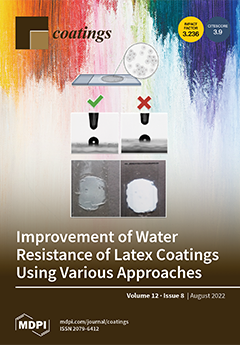We prepared amorphous indium–gallium–zinc oxide (
a-IGZO) thin films with various Ga content ratios and investigated their feasibility as the active channel layers of top-gate thin-film transistors (TFT). First, the 2-inch IGZO sputtering targets with stoichiometric ratios of InGaZn
2O
5
[...] Read more.
We prepared amorphous indium–gallium–zinc oxide (
a-IGZO) thin films with various Ga content ratios and investigated their feasibility as the active channel layers of top-gate thin-film transistors (TFT). First, the 2-inch IGZO sputtering targets with stoichiometric ratios of InGaZn
2O
5, InGaZnO
4, and InGa
2ZnO
5.5 were fabricated using In
2O
3, Ga
2O
3, and ZnO oxide powders as raw materials via sintering treatments at temperatures ranging from 900 °C to 1300 °C for 6 h or 8 h.
X-ray diffraction analysis indicated that the InGaZn
2O
5 and InGaZnO
4 targets are single-phase structures whereas the InGa
2ZnO
5.5 target is a two-phase structure. Hall effect measurement indicated that the
a-InGaZn
2O
5 and
a-InGaZnO
4 layers possess a carrier concentration (
N) of about 10
19 cm
−3 and a resistivity (
ρ) of about 10
−2 Ω·cm; however, the
N of the
a-InGa
2ZnO
5.5 layer is only 10
17 cm
−3, and the
ρ is about 1 to 4 Ω·cm. Moreover, the
a-InGaZn
2O
5 layer exhibited the highest Hall-effect mobility (
μHall) of 21.17 cm
2·V
−1·sec
−1. This indicated that the impedance of Ga
3+ ions to carrier migration is the main factor affecting the electrical properties of
a-IGZO layers. Ga content in the
a-IGZO channel similarly affects the performance of the TFT devices prepared in this study. The annealing at 300 °C for 1 h in an ambient atmosphere was found to significantly improve the electrical properties of the TFT devices. The best performance was observed in the
a-InGaZnO
4 TFT sample subjected to post-annealing at 300 °C with
Vth = −0.85 V,
μFE = 8.46 cm
2, V
−1·sec
−1,
SS = 2.31, V·decade
−1, and
Ion/
Ioff = 2.9 × 10
4.
Full article





